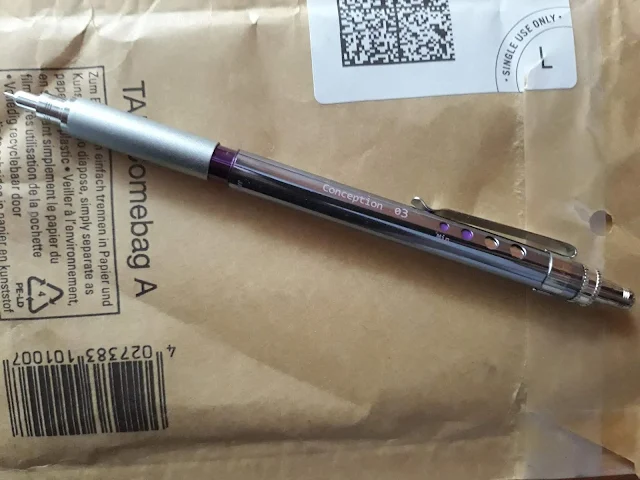
I will start with, science is hard, or at least my pseudoscience is. I will test how the most common lead size perform:
0.5 / 0.7 / 0.9 or 1.0
0.9 and 1.0 is the same size, but different producers refer to it differently. From now on, I will refer to both sizes as 1.0
I guess you already have the answer to my question. Which ever lead size you like the most is the best, and I probably say 0.7 is the most usual lead of them all. But I am going further with my quest. So prepare ...
The so-called test
I wanted to see how much lead is used for the same amount of writing using each of the lead sizes mentioned above.
This is hard work, and I do not think I will be doing science anytime soon after all this experimenting.
I used Rotring HB leads with the aforementioned sizes 0.5; 0.7; 1.0. Other brands might offer different results because of the lead hardness "... 2B B HB H 2H ..." is not standardized. So HB from other suppliers might be softer or harder.
I started the test by writing 1-page size A4 (254x297 mm). To be as consistent as humanly possible, I used "math" paper and wrote in every single cell of the paper with very little pressure, and the same letter height, the letters of the alphabet over and over again. I preferred this method instead of freehand, so the results will be as scientific as correct as they can get.
This is not representative of real world writing, but it doesn't have to be. The important part of the test is comparing the leads to each other and see what are the differences.
After I wrote a few pages with each of the leads that are participating in the writing test, I measured the length of the remaining lead.
The results
In theory, I could have written with a single lead, size 0.5 mm, - 30 pages, but I have to take into account that when the lead becomes too small you have to throw it away, so more realistic I would say 27 pages.
Of course, this depends a lot on how small or big do you write, how condensed, how much pressure etc. So don't focus on this figure, as it is not the important one. The difference between the test results says the story.
The 0.7 mm can write in theory 60 pages and the 1.0 mm over 120 pages. This means that the writing you are able to do with 1 lead doubles every time you bump up the lead size.
Because I could not measure the lead used up on a single page with size 1.0 (under half of mm) I cranked up the pace and applied extra pressure and made a bunch of lines and X.
So after the endurance test the 0.5 mm lost 3.5 mm; the 0.7 mm lost 1.5 mm, and the 1.0 lost 0.5 mm from its total length
It does not seem a lot but assuming I could use the entire lead, 60 mm, the 1.0 size I could do as much writing as with 3 pieces of 0.7 mm lead or 7 pieces of 0.5 lead.
Similarly, if you would take the 0.7 mm as a benchmark, then I would need 2.33 pieces of 0.5 mm lead to do the same amount of writing.
Conclusion
You should choose the thicker lead, especially if you have a heavier hand, for three reasons.
1) The first reason is the price. The price of lead is usually the same for all thicknesses.
You will pay 3 times more if you use 0.7 lead instead of 1.0
You will pay 7 times more if you use 0.5 lead instead of 1.0
You will pay 2.33 times more if you use 0.5 lead instead of 0.7
2) The second reason is the advancing of the lead. The less lead you use, fewer clicks you will have to make. So in a long writing session, a thicker lead is bliss.
3) And third, the risk of breaking the lead is smaller with thicker lead.
Ok, you may ask, "Won't the line be too thick if I use 1.0 mm?"
It will, but not by a lot. There is a small difference between the 0.7 mm and the 1.0 mm lead. The downside is that you have to rotate the pen in your hand more often when you use 1.0 mm lead.
 |
| 1.0 mm vs 0.5 mm lead |
 |
| 1.0 mm vs 0.7 mm lead |











